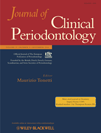Vaccination of mice with Porphyromonas gingivalis or Fusobacterium nucleatum modulates the inflammatory response, but fails to prevent experimental periodontitis*
Conflict of interest and source of funding statement The authors declare that they have no conflict of interest.The present work is part of a PhD thesis by David Polak. The research was carried out at the MIS-supported Laboratory for Periodontal Research and the Ronald E. Goldstein Center for Esthetic Dentistry and Dental Materials Research, at The Hebrew University-Hadassah Medical center, Faculty of Dental Medicine. The study was supported by a Chief Scientist Grant from the Israel Ministry of Health.
* Jaccard competition finalist Europerio 6 Stockholm, 2009.
Abstract
Polak D, Wilensky A, Shapira L, Weiss EI, Houri-Haddad Y. Vaccination of mice with Porphyromonas gingivalis or Fusobacterium nucleatum modulates the inflammatory response, but fails to prevent experimental periodontitis. J Clin Peridontol 2010; 37: 812–817. doi: 10.1111/j.1600-051X.2010.001598.x.
Aim: To assess the potential of using vaccination with Porphyromonas gingivalis or Fusobacterium nucleatum, in modulating local subcutaneous inflammatory response and alveolar bone loss following coinfection with both bacteria.
Materials and Methods: Mice were immunized against either P. gingivalis or F. nucleatum. The cytokine response to mixed infection with P. gingivalis and F. nucleatum was evaluated using the subcutaneous chamber model. The alveolar bone loss induced by oral mixed infection was evaluated by micro-CT using the experimental periodontitis model. Serum levels of specific antibodies were determined by ELISA.
Results: Vaccination with either bacterium produced a specific humoral response before infection. Animals immunized against either bacteria following a mixed infection with P. gingivalis and F. nucleatum, showed decreased TNFα (but not IL-1β) levels as compared with non-immunized animals. However, the vaccination did not change the level of mixed infection-induced alveolar bone loss when compared with non-immunized animals. Six weeks following the oral mixed infection, specific antibody titres remained high. Furthermore, specific antibodies against the non-immunized bacterium were present at high levels.
Conclusions: While vaccination produced specific antibodies and suppressed the inflammatory response, it failed to prevent or reduce the progression of experimental periodontitis induced by mixed infection with P. gingivalis and F. nucleatum.




